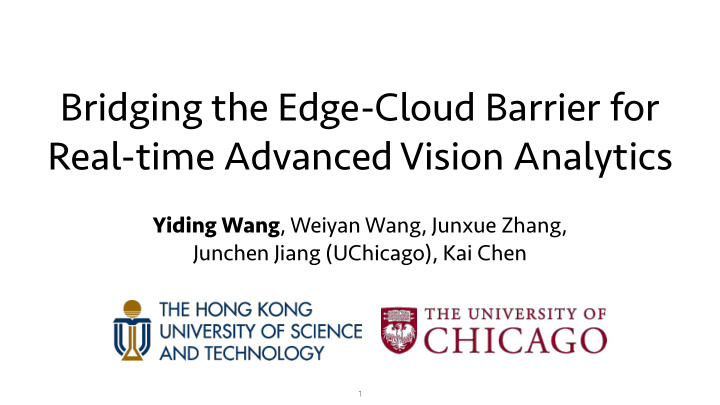



Bridging the Edge-Cloud Barrier for Real-time Advanced Vision Analytics Yiding Wang , Weiyan Wang, Junxue Zhang, Junchen Jiang (UChicago), Kai Chen � 1
(Edge-to-cloud) vision analytics are ubiquitous • Large scale deployment of cameras: tra ffi c monitoring, event detection • Vehicles/robots with cameras: autonomous driving vehicles/robotics/drones Object detection Semantic segmentation � 2
Advanced applications are demanding • Example: segmentation and object detection tasks for autonomous driving • Real-time-level interaction requires low latency • High inference accuracy requires high fidelity data and computing resource • Currently advanced applications run heavy vision inference tasks on the edge . “Real-time video analytics: the killer app for edge computing” –Ganesh Ananthanarayanan etc. • But it makes sense to consider a cloud-based solution. � 3
Potential benefits of the cloud • Reducing the requirements for edge devices, thus making the large-scale deployment cheap. • High-end autonomous driving vehicles vs. delivery robots/vehicles � 4
Challenges The edge-to-cloud real-time advanced vision applications face strict bandwidth-accuracy trade-o ff : 1. Accuracy : demanding applications → high accuracy → high quality data 2. Bandwidth : high quality camera feeds → high network bandwidth usage � 5
Idea #1: cropping Sending only cropped areas of region-of-interest (ROI). (Reinventing Video Streaming for Distributed Vision Analytics, Pakha et al., HotCloud 2018). Limitation: For advanced applications, ROI is is the full frame. → Cannot crop. � 6
Idea #2: frame filtering Filtering the relevant frames and streaming them to the cloud. (Scaling Video Analytics On Constrained Edge Nodes, Canel et al., SysML 2019) Limitation: Works well for always-on stationary tra ffi c camera feeds, but not for a moving vehicle/robot : relevant objects are always in the scene. � 7
Idea #3: harmless degradation Using a task-specific degradation config. (AWStream: Adaptive Wide-Area Streaming Analytics, Zhang et al., SIGCOMM 2018) Stationary Mobile Camera Camera Figures from AWStream Mobile cameras: value frame rate . Stationary cameras: value resolution Limitation: Advanced applications require both high frame rate and resolution. 4 × downsampling → 13% loss on mIoU, 20% on small yet critical object classes � 8
Our work • CloudSeg, an edge-to-cloud framework for advanced vision analytics that achieves both low latency and high inference accuracy with analytics-aware super-resolution . • CloudSeg saves bandwidth by recovering the high-resolution frames from the low-resolution stream via super-resolution . • CloudSeg keeps high accuracy via SR tailored for the actual analytics tasks. � 9
Design of CloudSeg framework Low extra latency (6.2ms) with an e ffi cient SR model on the GPU server. � 10
Bandwidth usage saving With CloudSeg, downsampling 2K frames to 512 × 256 can reduce 13.3 × bandwidth usage with 2.6% accuracy (mIoU) loss for semantic segmentation. To achieve the same accuracy, AWStream needs to stream 720p feed, thus CloudSeg can reduce bandwidth use by 6.8 × compared with AWStream. � 11
Inference accuracy on critical details • Some classes in Cityscapes dataset are very insensitive to input resolutions: sky, road, wall, building, etc. • Others e.g. rider, bicycle, motorcycle, tra ffi c sign/light, person are sensitive to the input quality and also critical to the real-world applications. • Observation: There is a mismatch between goals of SR and analytics tasks. � 12
Analytics-aware super-resolution • Target of SR training: reduce the backend model inference accuracy loss • Especially improve the accuracy on small objects, compared with vanilla SR • 2.6% accuracy loss compared with HR frames � 13
Promising results • 6.8 × bandwidth saving compared with AWStream, at same inference accuracy 2.6% accuracy (mIoU) loss compared with original 2K frames (13.3 × larger) 0.7 10000 0.65 7500 Bandwidth Consumption (kbps) Accuracy (mIoU) 0.6 5000 0.55 2500 0.5 0 No AWStream CloudSeg No AWStream CloudSeg degradation (1440×720) (512×256) degradation (1440×720) (512×256) (2048×1024) (2048×1024) � 14
Summary • Enabling edge-to-cloud real-time advanced vision analytics is meaningful. The key technical challenge is the strict bandwidth-accuracy trade-o ff . • The design of CloudSeg is a first step to tackle the trade-o ff with analytics- aware super-resolution . • Promising results: 6.8 × bandwidth saving compared with directly downsampling, with negligible drop in accuracy compared with original video. � 15
Recommend
More recommend